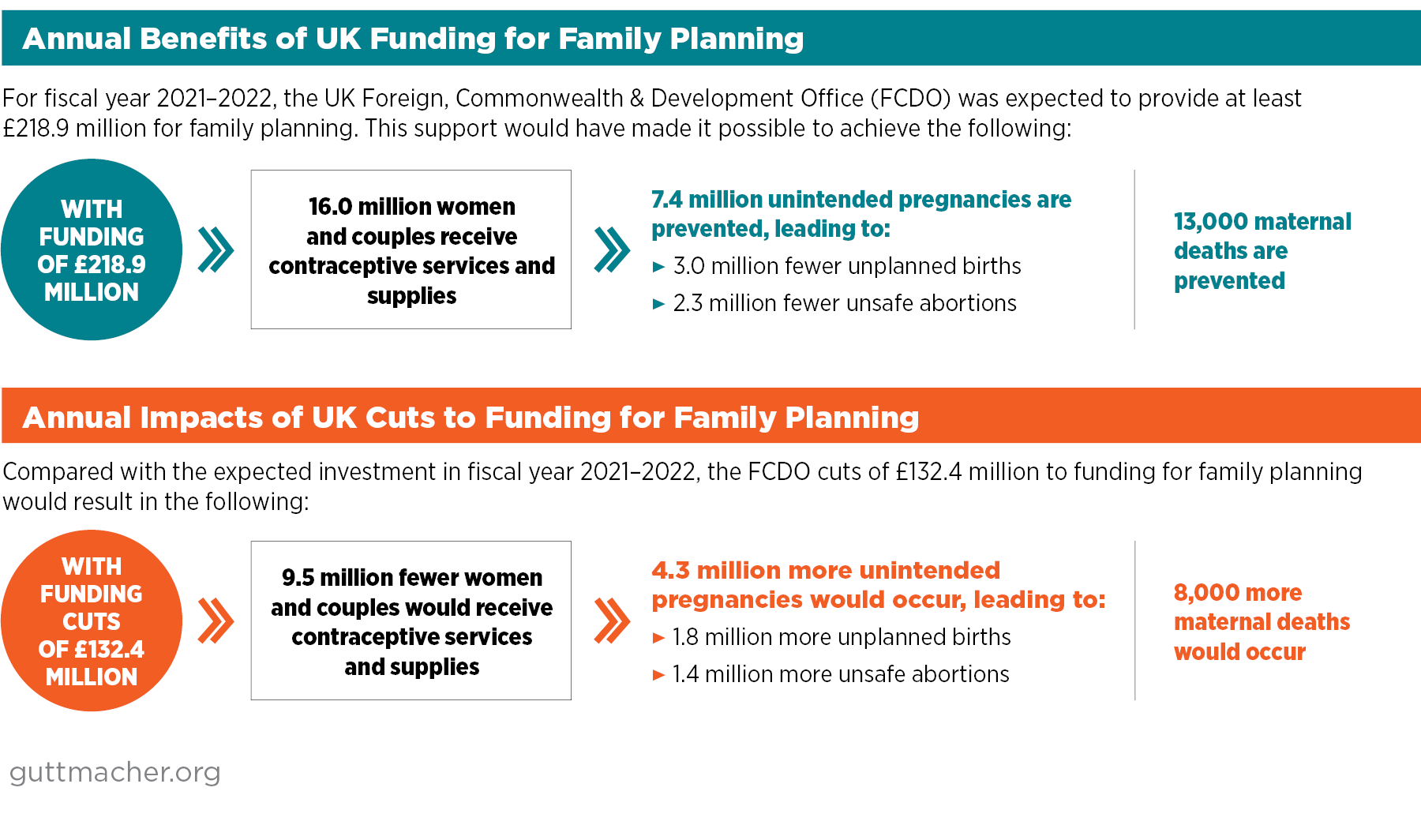Investments in sexual and reproductive health and rights have profound and measurable benefits: Not only do they promote health and well-being throughout people’s lives, but they can also lead to improvements in education, gender equality, political stability, economic development and environmental sustainability.1
UK support for family planning
Family planning is a fundamental component of comprehensive sexual and reproductive health services. The United Kingdom, through its Foreign, Commonwealth & Development Office (FCDO), plays a critical role in bringing voluntary family planning information, services and supplies to countries where the need is greatest. As one of the main architects of the Family Planning 2020 initiative,2 the United Kingdom has been a global leader in support for family planning. The United Kingdom was also the largest funder in 2019 of the United Nations Population Fund Supplies program, itself the world’s largest provider of donated contraceptives and an important source of support for reproductive health services in humanitarian crises.3,4 Furthermore, the United Kingdom recognizes that ongoing consequences of the COVID-19 pandemic, including increases in unintended pregnancy and unsafe abortion, require reaffirming its full commitment to protecting the sexual and reproductive health and rights of all individuals.5
As a part of the United Kingdom’s international development funding, FCDO supports sexual and reproductive health and rights organizations that provide essential health services and policy and program support in low- and middle-income countries. However, in November 2020, the government announced a reduction in its development funding from 0.7% of gross national income to 0.5%. When surveyed, major sexual and reproductive health organizations reported they expected to receive at least £218.9 million in fiscal year (FY) 2021–2022 (from April 2021 to March 2022) for family planning activities in low- and middle-income countries. Resulting cuts to the family planning programs of these major program-implementing organizations are estimated to have totaled £132.4 million in FY 2021–2022.
The graphic below shows the expected impacts of the planned level of investment and how drastic cutbacks in funding for family planning will reduce those impacts by decreasing the numbers of contraceptive users served and unintended pregnancies prevented—therefore increasing unplanned births, unsafe abortions and maternal deaths. The cuts to family planning made by FCDO, especially as countries grapple with the effects of COVID-19, represent a sizable setback in global health. Diminished family planning services create long-lasting negative consequences for girls and women around the world and derail progress toward gender equality.
In addition to family planning, FCDO’s sexual and reproductive health and rights portfolio includes efforts to provide comprehensive abortion care and maternal and newborn health care, end child marriage and gender-based violence, and integrate family planning with sexual and reproductive health services for marginalized and hard-to-reach populations (e.g., people living in poverty, adolescents and people living with a disability). These actions are essential to the goal of ending the preventable deaths of women and newborns in the developing world by 2030, for which the United Kingdom has pledged to step up its efforts.6
Fully investing in family planning as part of an essential package of health services not only saves lives and improves adolescents’ and women’s health and well-being, but it also results in cost savings. Evidence for 132 low- and middle-income countries in 2019 shows that, on average, every U.S. dollar spent on contraceptive services beyond the current level would reduce the cost of maternal, newborn and abortion care by three dollars7 and would lead to cost savings at the country level as well.8
Methodology and sources
Information for FY 2021–2022 on FCDO’s expected funding for sexual and reproductive health and rights, as well as on related funding cuts, is from reports by major implementing organizations in May and June 2021.9 Funding amounts for family planning activities were estimated based on FCDO project funding information.10 Country-level funding was estimated from information provided by implementing organizations. Technical information used to generate the results is available at https://osf.io/5kdfz/.
To estimate the annual number of contraceptive users served by funding in FY 2021–2022, we divided expected funding and funding cuts by the average annual cost of contraceptive use, which comes from the most recent comprehensive analysis of costs and impacts of family planning in low- and middle-income countries.7,11 Country-level per-user costs were updated to 2020 U.S. dollars and converted to British pounds sterling. We estimated country-level impacts from 2019 findings from the same analysis. Annual total impacts were estimated as the difference between the annual number of events expected to occur among women using modern methods and the number that would occur if they relied instead on traditional methods or no method.
Declaration of interest
The Guttmacher Institute received FCDO funding in FY 2021–2022 and is among the organizations that received a funding cut. These impact estimates do not include the Institute’s FY 2021–2022 FCDO funding or funding cut.


